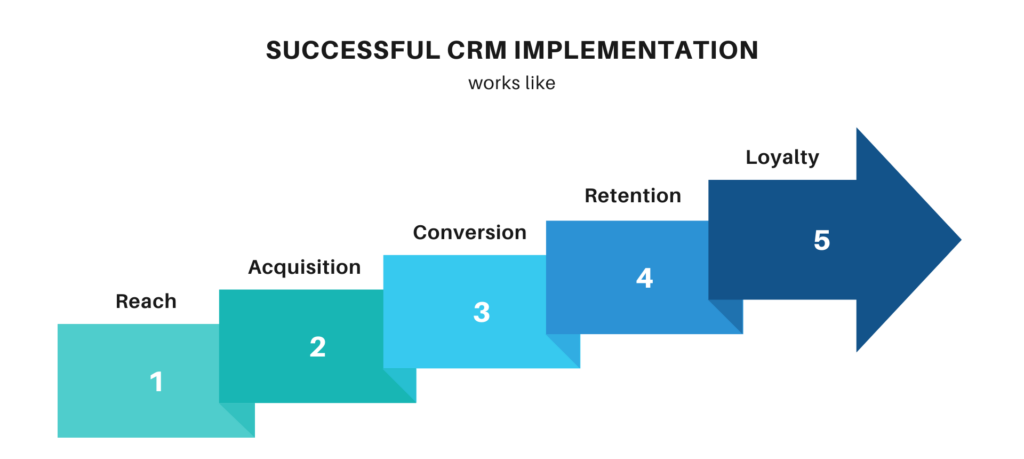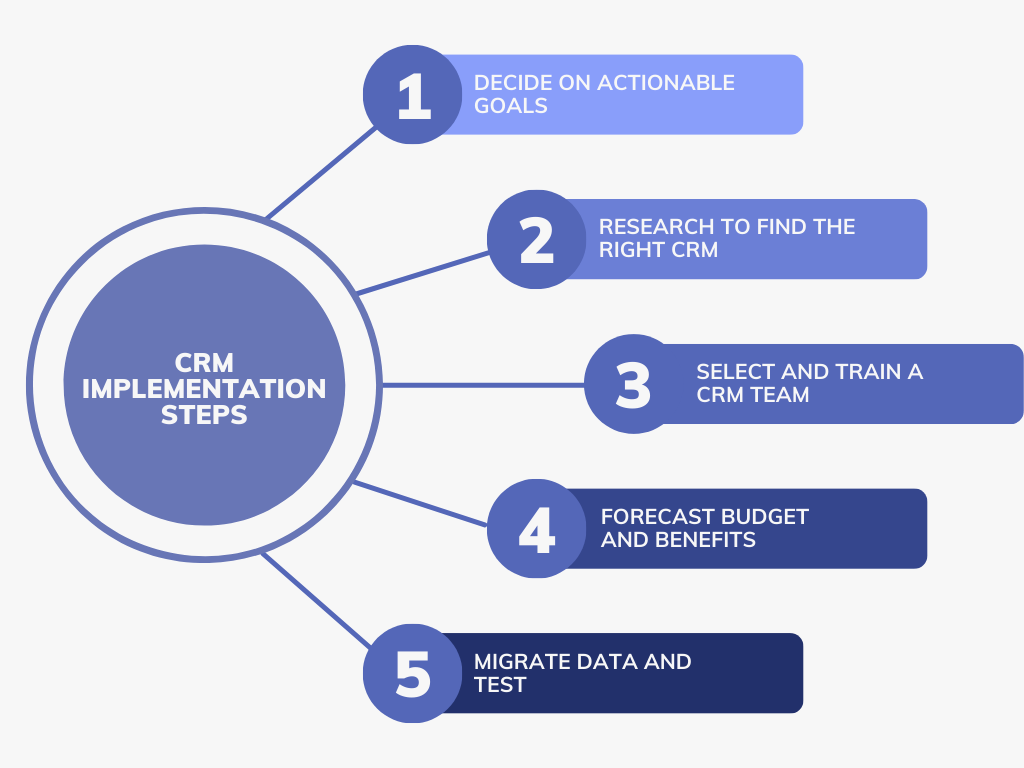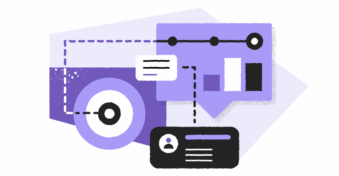CRM stands for Customer Relationship Management and refers to software that helps you manage your leads and clients. This software further helps streamline your business operations and is crucial to any successful company. However, if you don’t do the CRM implementation right, you risk setting your business back more than the software will help. Read further as we look at the CRM implementation phases and consider why completing these steps is essential.
What Is CRM Implementation?
CRM implementation refers to launching new CRM software and systems for your business. While installing the software is a big part, that’s not all you need to consider. Part of how to implement a CRM system is ensuring you streamline the process and include the proper training for your employees. The term refers to the process of deploying a new system or integrating it with existing systems.
In a nutshell, a CRM implementation plan can be described with the following points:
- Defining your goals for this process.
- Researching and choosing the right system for your business.
- Preparing for smooth data migration of the correct information.
- Training the end-users, your employees, appropriately.
A successful implementation process can also be described as the following steps:
- Reach
- Acquisition
- Conversion
- Retention
- Loyalty

How Does a Properly Implemented CRM System Impact Your Business?
Part of this process is that it’ll benefit your business operations. Having a proper game plan saves time and money and means you have access to accurate data as soon as possible. Below, we consider some of the impacts you’ll see in your business after a successful CRM implementation.
Automates Workflow
After successfully installing all software and processes, you’ll find it automates your workflow. CRM software gives you access to tools like reminders, automated emails, and more, which helps keep your business going. You don’t need to worry about customers slipping through the cracks, as it’ll send reminders and more about critical data.
Since you also have all the information in one place, it’ll help enhance your decision-making and refine the focus of your customer support and marketing efforts. As such, it also gives you a transparent view of your clients, helping you personalize and further automate any campaign.
Ability to View Reports
A CRM implementation strategy saves time once installed, as you can quickly check reports on everything happening instead of checking in with each employee. Now you can stay in the loop, and you can also set permissions on who’s able to view reports and export data.
Unlike people who can make an error, this software will record all the relevant data, giving you an accurate glance at how your company is doing. It also helps ensure you can access the reports from anywhere and share them easily with others.
Optimizes Sales
Since you’ve streamlined the process, you can experience better marketing efforts, which result in higher sales. A complete CRM implementation plan will give you the tools to help your marketing and sales manager optimize their operations. It makes their jobs easier, which results in more profits for the business.
Scalability
Part of looking into “What is CRM implementation?” is knowing that most software solutions are scalable. You might have only just gotten enough employees and customers to require CRM, but you’ll likely keep growing. Most CRM solution scale with your company.
If you’re a small business, you can start with one of the various free solutions, like the Inbox CRM for Gmail from PandaDoc. However, as you grow, you might require more comprehensive solutions. Most brands offer multiple packages, and you can get a more comprehensive package as you grow, which means these solutions have excellent scalability.
Increase Customer and User Experience
This type of software also helps improve your user experience. With one consolidated platform with all the information, you can easily collaborate between departments. Sales, marketing, and financial departments can effectively communicate and share documents, ensuring you have a cleaner experience and pipeline.
It’s not just you and your employees who’ll experience an improved process, but also your customers. CRM software provides a dedicated platform that streamlines the booking system. Whether you’re in hospitality, tourism, retail, or any other sector, the software ensures clients can easily reach you and enjoy a user-friendly experience.
Improved Data Security
The last benefit is the increased security you enjoy with your cloud storage and servers. Not only can you ensure you don’t lose critical information when systems crash, but the software also uses security features to protect sensitive information. Overall, you have better-secured storage for customer information, which helps protect it against cybercriminals and hackers.
What Makes a Successful CRM Implementation Plan?
While a CRM has the potential to increase your sales and streamline your operations, some statistics show more than half of all CRM implementing plans fail. However, we look at how to create a successful strategy using the 10-step guide that’s proven to be almost foolproof if done correctly.
- Start by mapping out your needs and goals for this process.
- Review various CRM software options and choose the best one for your purposes.
- Consider which integrations you’ll need, and prepare your data for transfer.
- Build your implementation team, ensuring they understand the process.
- Decide which criteria there are for successful goals, KPIs, and metrics.
- Plan a budget for your finances and timeline.
- Clean and prep CRM data on the installed software.
- Add other CRM users, like your sales and marketing managers.
- Test the CRM for an initial trial period to see how it works.
- Analyze the feedback from the trial period and implement it fully if successful.
Importance of CRM implementation
We talked about the benefits of implementing a CRM system, but we also looked at why CRM is important in the first place. Without this software, your records are all in different storages, and notes and attachments to clients can be challenging to find.
You might also find that some files are lost or damaged over time, or you lose leads due to inefficient operations. All the above are reasons that explain why you should implement this software.
However, it doesn’t explain why a CRM implementation strategy is so important. A successful strategy is critical since it helps your company avoid losses. That’s the one reason all other reasons narrow down to. You waste time and money preparing for a process that fails and can lose customers during that unsuccessful transition period.
However, by following our step-by-step CRM implementation plan template, you can avoid losses and integrate them with your existing operations and systems as soon as possible.
How to Implement a CRM System?
While the 10-step guide is a comprehensive solution to implementing your CRM, we discuss compacted CRM implementation steps below to help get you started.

Step 1: Decide on Actionable Goals
Before you implement anything, you must have clear and actionable goals. That means sitting down and thoroughly considering what you want to achieve using this system. Don’t consider the software an extension but an integrated part of your operations. Don’t consider which tools you want first, but rather what you want to do.
If your goal is to increase specific sales, note that down. Consider whether you want to add to your existing process or do a complete overhaul. Once you’ve listed your goal, you can start looking for software to fit that purpose.
Step 2: Research to Find the Right CRM
You’ve not decided on your goals, so the next step is looking into the available software. There are a few things you should consider when choosing a CRM:
- Cost
- Integrations
- Scalability
- Ease of use
- Available tools
- Reputation
The above factors are all crucial in picking a solution that’ll work for your business. There are numerous options, so you can always test a free system first to understand what you need without wasting money. Once you know what you need, narrow the choices down to your top three, and create a pros and cons list for each. This should help you decide on the right software.
Step 3: Select and Train a CRM Team
It’s better to start small instead of simply installing software and new processes and training all your employees. Form a specific CRM implementation phases team, and give them the training they need to understand the new system. Ensure each member properly understands it and creates particular roles for them. Typical roles beneficial during the implementation are the following:
- Project Manager – This person is the leader and will manage the entire change and performance.
- Systems Developer – This position is for the one who’ll oversee the installation and integration of the software.
- Data Analyst – The analyst manages data migration and helps ensure all the data is transferred correctly.
- QA Engineer – In charge of the testing, this person will analyze how the system works and whether there are sections to improve.
- Champions – The last group is your representatives of various departments. These champions will learn how the system works, and if you fully implement it, they’ll be in charge of helping the daily users learn how to manage it.
Step 4: Forecast Budget and Benefits
A forecast is a crucial element to help you understand whether the CRM implementation project plan template is going as planned. You must outline the timeline of the implementation process and how much you judge it’ll cost.
You must consider where production times may dip and when resources will be focused on training employees. This forecast should also include the benefits employees should experience. That way, if they don’t experience the benefits, you know a section needs improvement.
Step 5: Migrate Data and Test Integrated Systems
The last step is both the most essential and time-consuming one. That’s data migration and ensuring all your information is completely transferred. This step can take weeks, as you need to check whether all customer data migrates, replace any lost information, and ensure your systems are up and running.
This step also includes changing your preferred settings, like detailing automated emails and your brand image. However, once it’s done, you can start testing the software. Part of the CRM implementation guide is understanding how it works after the implementation. You analyze the results, and if it works as intended, you can start making steps to scale it up to the entire company.
Final Thoughts
We’ve looked at what it is and how to implement CRM software, so you know why this process is essential. Almost any business with more than 10 employees uses this software, as it helps you streamline operations and improve customer experience and sales. However, you need a successful plan to implement it. Otherwise, you run the risk of losing money and time to it.
If you’re looking for a free solution that’s more user-friendly, then the Inbox CRM from PandaDoc is an ideal option. It integrates fully with your Gmail and helps you create a custom pipeline for the various team members. You can get the Inbox CRM from PandaDoc from the Chrome Web Store, install it within minutes, and see whether this software helps you streamline your business operations.
FAQs
-
The cost of CRM implementation depends on the size of your company. If you have a smaller company, then there are fewer resources you have to use, so the costs are less. However, larger companies require more resources and sometimes even an implementation expert to advise them of the process. The software can cost anything from $10/month to $5,000/month.
-
The timeline for implementing these systems varies depending on if you’re doing a complete overhaul or a partial integration and the size of your company. It can take up to four months because a lot of data migration can take weeks. However, it can also go quite fast, like two weeks, especially if you get the help of an expert or use a free tool.
-
It depends on the team you pick, but overall, you need at least five people to be part of the process. One is the team leader, another handles the software installation, while another ensures all the data transfers as they should. The last two members are the person who tests the system and then the one who learns about it to train others in its use.
-
You end the implementation once you’re sure it works as intended. The last step is to test the system and analyze the results to close it out. It means researching whether your goals are met, whether other employees can use the system adequately, and if the new software meets all your requirements.
-
Various reasons exist why this process fails, with the most relevant being a lack of clear goals or the non-cooperation of your team. You can also be set back by using the wrong software or inadequately assigning resources, finances, and time to the project. Overall, it’ll fail if you don’t have management support and training.


